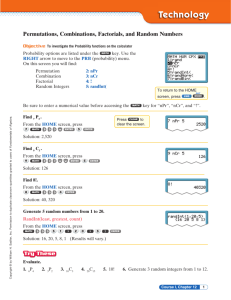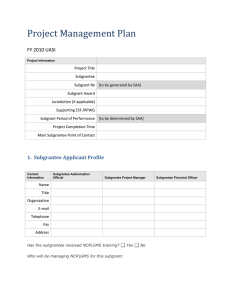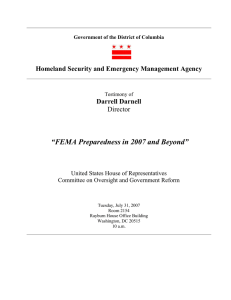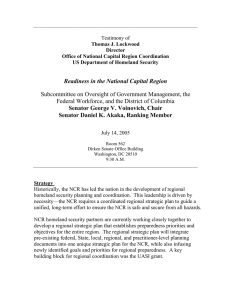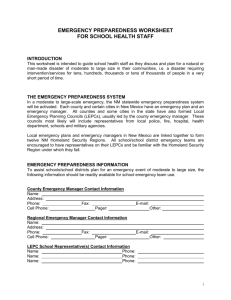GAO
advertisement
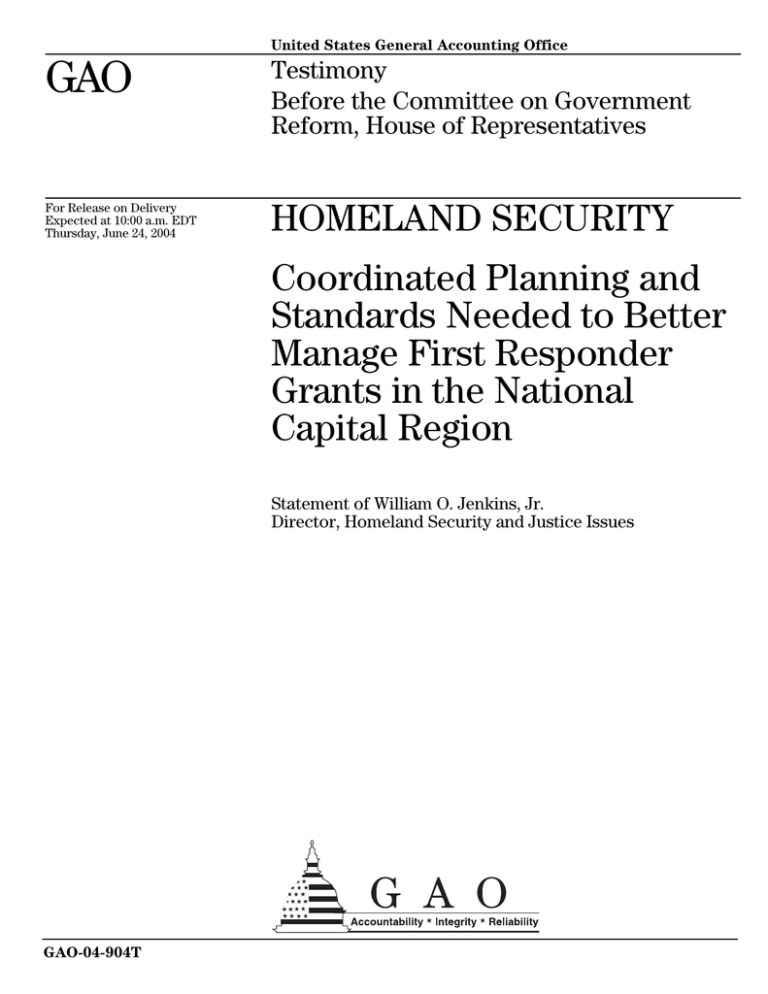
United States General Accounting Office GAO Testimony Before the Committee on Government Reform, House of Representatives For Release on Delivery Expected at 10:00 a.m. EDT Thursday, June 24, 2004 HOMELAND SECURITY Coordinated Planning and Standards Needed to Better Manage First Responder Grants in the National Capital Region Statement of William O. Jenkins, Jr. Director, Homeland Security and Justice Issues GAO-04-904T June 24, 2004 HOMELAND SECURITY Highlights of GAO-04-904T, a testimony before the Chairman, Committee on Government Reform, House of Representatives Since the tragic events of September 11, 2001, the National Capital Region (NCR), comprising jurisdictions including the District of Columbia and surrounding jurisdictions in Maryland and Virginia, has been recognized as a significant potential target for terrorism. GAO was asked to report on (1) what federal funds have been allocated to NCR jurisdictions for emergency preparedness; (2) what challenges exist within NCR to organizing and implementing efficient and effective regional preparedness programs; (3) what gaps, if any, remain in the emergency preparedness of NCR; and (4) what has been the role of the Department of Homeland Security (DHS) in NCR to date. GAO recommends that the Secretary of DHS (1) work with local NCR jurisdictions to develop a coordinated strategic plan to establish capacity enhancement goals and priorities; (2) monitor the plan’s implementation; and (3) identify and address gaps in emergency preparedness and evaluate the effectiveness of expenditures by conducting assessments based on established standards and guidelines. Coordinated Planning and Standards Needed to Better Manage First Responder Grants In the National Capital Region In fiscal years 2002 and 2003, grant programs administered by the Departments of Homeland Security, Health and Human Services, and Justice awarded about $340 million to eight NCR jurisdictions to enhance emergency preparedness. Of this total, the Office for National Capital Region Coordination (ONCRC) targeted all of the $60.5 million Urban Area Security Initiative funds for projects designed to benefit NCR as a whole. However, there was no coordinated regionwide plan for spending the remaining funds (about $279.5 million). Local jurisdictions determined the spending priorities for these funds and reported using them for emergency communications and personal protective equipment and other purchases. NCR faces several challenges in organizing and implementing efficient and effective regional preparedness programs, including the lack of a coordinated strategic plan for enhancing NCR preparedness, performance standards, and a reliable, central source of data on funds available and the purposes for which they were spent. Without these basic elements, it is difficult to assess first responder capacities, identify first responder funding priorities for NCR, and evaluate the effectiveness of the use of federal funds in enhancing first responder capacities and preparedness in a way that maximizes their effectiveness in improving homeland security. National Capital Region Jurisdictions Montgomery County District of Columbia City of Alexandria Fairfax County DHS and the ONCRC Senior Policy Group generally agreed with GAO’s recommendations and noted that a new governance structure, adopted in February 2004, should accomplish essential coordination. www.gao.gov/cgi-bin/getrpt?GAO-04-904T To view the full product, including the scope and methodology, click on the link above. For more information, contact William O. Jenkins, Jr., at (202) 512-8757 or jenkinswo@gao.gov. Arlington County Loudoun County Prince William County Virginia Maryland Source: National Capital Planning Commission. Prince George's County Mr. Chairman and Members of the Committee: I appreciate the opportunity to testify on the results of our work on the management of first responder grants in the National Capital Region (NCR). Our report is being released today, and my testimony highlights the major findings and recommendations of that report. 1 Our report addressed the following questions: • What federal funds have been allocated to local jurisdictions in NCR for emergency preparedness, for what specific purposes, and from what sources? • What challenges exist within NCR to organizing and implementing efficient and effective regional preparedness programs? • What gaps, if any, remain in the emergency preparedness of NCR? • What has been the Department of Homeland Security’s (DHS) role to date in enhancing the preparedness of NCR through such actions as coordinating the use of federal emergency preparedness grants, assessing preparedness, providing guidance, targeting funds to enhance preparedness, and monitoring the use of those funds? To respond to these questions, we met with and obtained documentation from officials of DHS including its Office for National Capital Region Coordination (ONCRC), the Senior Policy Group, the Metropolitan Council of Governments, state emergency management agencies, and first responder officials from NCR jurisdictions. We identified 25 emergency preparedness programs that provided funding to NCR jurisdictions in fiscal years 2002 and 2003, and we selected 16 of them for detailed review. These 16 grants were selected to cover a range of programs, including the largest funding sources; grants provided for general purposes, such as equipment and training; and grants provided for specific purposes, such as fire prevention and bioterrorism. We collected and analyzed grant data from federal, state, and local sources; and reviewed relevant reports, studies, and guidelines on homeland security and domestic preparedness. 1 See Homeland Security: Management of First Responder Grants in the National Capital Region Reflects the Need for Coordinated Planning and Performance Goals, GAO-04-433, (Washington, D.C.: May 28, 2004), Page 1 GAO-04-904T We conducted our review from June 2003 through February 2004 in accordance with generally accepted government auditing standards. Summary • In fiscal years 2002 and 2003, the DHS, the Department of Justice, and the Department of Health and Human Services awarded about $340 million through 16 grants to NCR jurisdictions. Of these funds, $60.5 million were from the Urban Area Security Initiative grant, designated for region-wide needs, and the Office of National Capital Region Coordination has developed a regional plan for their use. The remaining funds, about $279.5 million, were available to local jurisdictions for a wide variety of needs, such as equipment and training, and local jurisdictions determined how these funds were to be spent. Local jurisdictions used or planned to use monies from those grants to buy equipment and to implement training and exercises for the area’s first responders, as well as improve planning for responding to a terrorist event. But, spending for these purposes was not generally based on a coordinated plan for enhancing regional first responder capacities and preparedness. • ONCRC and the NCR face at least three interrelated challenges in managing federal funds in a way that maximizes the increase in first responder capacities and preparedness while also minimizing inefficiency and unnecessary duplication of expenditures. These challenges are (1) a lack of preparedness standards; (2) a coordinated region-wide plan for establishing first responder performance goals, needs, and priorities and assessing the benefits of expenditures in enhancing first responder capabilities; and (3) the lack of a readily available, reliable source of data on the federal grant funds available to first responders in NCR, budget plans and criteria used to determine spending priorities, and actual expenditures. Without the standards, a region-wide plan, and needed data on spending, it is extremely difficult to determine whether NCR first responders have the ability to respond to threats and emergencies with well-planned, well-coordinated, and effective efforts that involve a variety of first responder disciplines from NCR jurisdictions. • During our review, we could identify no reliable data on preparedness gaps in the NCR, which of those gaps were most important, and the status of efforts to close those gaps. The baseline data needed to assess those gaps had not been fully developed or made available on a NCR-wide basis. • To date, DHS and ONCRC appear to have had a limited role in assessing and analyzing first responder needs in NCR and developing a coordinated effort to address those needs through the use of federal grant funds. ONCRC has focused principally on developing a plan for using the Urban Page 2 GAO-04-904T Area Security Initiative funds. In its comments on a draft of our report, DHS said that a governance structure approved in February 2004, should accomplish essential region-wide coordination. Background Since September 11, 2001, the federal government, state and local governments, and a range of independent research organizations have agreed on the need for a coordinated intergovernmental approach to allocating the nation’s resources to address the threat of terrorism and improve our security. The need for a coordinated approach was most recently stated in the report of the Homeland Security Advisory Council,2 released earlier this month: Arguably, while each at-risk locality must be provided adequate resources to effectively fight this war, no single jurisdiction or response discipline can fight it alone. Effective homeland security efforts require continuous regional collaboration and coordination. Such an approach includes developing national guidelines and standards and monitoring and assessing preparedness against those standards to effectively manage risk. The National Strategy for Homeland Security, released in 2002 following the proposal for DHS, emphasized a shared national responsibility for security involving close cooperation among all levels of government and acknowledged the complexity of developing a coordinated approach within our federal system of government and among a broad range of organizations and institutions involved in homeland security. The national strategy highlighted the challenge of developing complementary systems that avoid unintended duplication and increase collaboration and coordination so that public and private resources are better aligned for homeland security. The national strategy established a framework for this approach by identifying critical mission areas with intergovernmental initiatives in each area. For example, the strategy identified such initiatives as modifying federal grant requirements and consolidating funding sources to state and local governments. The strategy further recognized the importance of assessing the capability of state and local governments, developing plans, and establishing standards and performance measures to achieve national preparedness goals. In addition, many aspects of DHS’ 2 U.S. Department of Homeland Security, The Homeland Security Advisory Council, A Report from the Task Force on State and Local Homeland Security Funding (Washington, D.C.: June 2004), p. 12. Page 3 GAO-04-904T success depend on its maintaining and enhancing working relationships within the intergovernmental system as the department relies on state and local governments to accomplish its mission. ONCRC Responsibilities Include Assessing Capabilities and Advocating for Needed Resources The creation of DHS was an initial step toward reorganizing the federal government to respond to some of the intergovernmental challenges identified in the National Strategy for Homeland Security. The Homeland Security Act established ONCRC within DHS to oversee and coordinate federal programs for, and relationships with, federal, state, local, and regional authorities in the NCR.3 Specifically, ONCRC was mandated to • coordinate the activities of DHS relating to NCR, including cooperating with the DHS’ Office for State and Local Government Coordination; • coordinate with federal agencies in the NCR on terrorism preparedness to ensure adequate planning, information sharing, training, and execution of the federal role in domestic preparedness activities; • coordinate with federal, state, and regional agencies and the private sector in NCR on terrorism preparedness to ensure adequate planning, information sharing, training, and execution of domestic preparedness activities among these agencies and entities; • serve as a liaison between the federal government and state, local, and regional authorities, and private sector entities in NCR to facilitate access to federal grants and other programs.4 With regard to resource assessments and needs, the NCR’s responsibilities also include • assessing and advocating for resources needed by state, local, and regional authorities in the NCR to implement efforts to secure the homeland and 3 P.L. 107-296 §882. 4 The Office of National Capital Region Coordination was also mandated to provide state, local, and regional authorities in NCR with regular information, research, and technical support to assist the efforts of state, local, and regional authorities in NCR in securing the homeland; and develop a process for receiving meaningful input from state, local, and regional authorities and the private sector in NCR to assist in the development of the federal government’s homeland security plans and activities. Page 4 GAO-04-904T • Grants Available to NCR Jurisdictions and Their Use submitting an annual report to Congress that (1) identifies resources required to fully implement homeland security efforts, (2) assesses progress in implementing homeland security efforts in the NCR, and (3) includes recommendations to Congress regarding additional resources needed to fully implement homeland security efforts in the NCR. In fiscal years 2002 and 2003, 16 separate federal grant programs conveyed about $340 million to state and local emergency management, law enforcement, fire, public health, and other emergency response agencies in NCR. Two funding sources—the fiscal year 2002 Department of Defense Emergency Supplemental Appropriation (almost $230 million) and the fiscal year 2003 Urban Area Security Initiative ($60.5 million) accounted for about 85 percent of those funds. The Urban Area Security Initiative funds were designated for regional use, and a plan has been developed for using the funds to benefit the region as a whole. These funds have been targeted for equipment ($26.5 million), planning ($12.4 million), exercises ($4 million), and administrative costs ($1.8 million), among other things. The other grant programs were not specifically designated for regional purposes, and spending for these funds was determined by individual local jurisdictions. These funds were available for such purposes as purchasing additional equipment and supplies for first responders; planning, coordinating, and evaluating exercises; training first responders; funding the emergency preparedness planning efforts and administration; and providing technical assistance. NCR jurisdictions reported using or planning to use these funds to purchase a range of equipment—for example, vehicles and communications equipment—supplies, training, and technical assistance services. Challenges to Using Coordinated, Effective Use of Federal Grants in NCR In our report, we discuss issues associated with managing federal first responder grants in NCR, assessing gaps in first responder capacities and preparedness in the region, and the role of the Office for National Capital Region Coordination in coordinating and assessing efforts to enhance first responder capacity across NCR. Effectively managing first responder federal grants funds requires the ability to measure progress and provide accountability for the use of public funds. A strategic approach to homeland security includes identifying threats and managing risks, aligning resources to address them, and assessing progress in preparing for those threats and risks. As with other major policy areas, demonstrating the results of homeland security efforts includes developing and implementing strategies, establishing baselines, developing and Page 5 GAO-04-904T implementing performance goals and data quality standards, collecting reliable data, analyzing the data, assessing the results, and taking action based on the results. The purpose of these efforts with regard to first responder grant funds to be able to answer three basic, but difficult, questions: • For what types of threats and emergencies should first responders be prepared? • What is required—for example, coordination, equipment, training—to be prepared for these threats and emergencies? • How do first responders know that they have met their preparedness goals? NCR is an example of the difficulties of answering the second and third questions in particular. Lack of Standards, Plans, and Data Limit Effective Grant Management to Guide First Responder Spending in NCR The region faces significant challenges in managing homeland security dollars. ONCRC and NCR jurisdictions face three interrelated challenges that limit their ability to jointly manage federal funds in a way that demonstrates increased first responder capacities and preparedness while minimizing inefficiency and unnecessary duplication of expenditures. First, a lack of preparedness standards for both equipment and performance means that it is difficult to assess first responder capabilities, identify gaps in those capabilities, and measure progress in closing those gaps. As in other areas of the nation generally, NCR does not have a set of accepted benchmarks (best practices) and performance goals that could be used to identify desired goals and determine whether first responders have the ability to respond to threats and emergencies with well-planned, well-coordinated, and effective efforts that involve police, fire, emergency medical, public health, and other personnel from multiple jurisdictions. Second, a strategic plan for the use of homeland security funds—whether in NCR or elsewhere—should be based on established goals, priorities, and measures, and align spending plans with those priorities and goals. At the time of our review, ONCRC had developed a regional spending plan for the Urban Area Security Initiative grants, but this plan was not part of a broader coordinated plan for spending federal grant funds and developing first responder capacity and preparedness in NCR. The lack of benchmarks and performance goals may contribute to difficulties in Page 6 GAO-04-904T developing a coordinated region-wide plan for determining how to spend federal funds and assessing the benefits of that spending. Third, there is no established process or means for regularly and reliably collecting data on (1) the amounts of first responder grants available to each jurisdiction and (2) the budget plans and criteria used for determining spending allocations and budget priorities. Reliable data are needed to establish accountability, analyze gaps, and assess progress toward meeting established performance goals. Without such data, it is difficult to verify the results of preparedness assessments and to establish a baseline that could be used to develop plans to address outstanding needs. It should be noted that the fragmented nature of the multiple federal grants available to first responders—some awarded to states, some to localities, some directly to local first responder agencies—may make it more difficult to collect and maintain region-wide data on grant funds received and the use of those funds in NCR. Guidance, Reliable Data Needed to Assess Remaining Gaps in First Responder Capabilities Without national standards, guidance on likely threats and scenerios for which to be prepared, coordinated plans, and reliable data, it is difficult for us or ONCRC to determine what gaps, if any, remain in the emergency response capacities and preparedness within NCR. Determining the existence of gaps in NCR’s emergency preparedness is difficult currently because there is little baseline data on the region’s preparedness, and DHS’s Office for National Capital Region Coordination does not have information on how NCR localities used federal grant dollars to enhance their capacities or preparedness. Even if those data were available, a lack of standards against which to evaluate the data would also have made it difficult to assess any gaps. The Office for Domestic Preparedness collected information on regional security risks and needs for NCR jurisdictions, and ONCRC based funding decisions for the Urban Area Security Initiative on the results. However, as already noted, it is not clear how the Urban Area Security Initiative spending plan links to the actual and planned uses for the other funding sources that comprised about $279.5 million of the $340 million in federal homeland security grants to the NCR during fiscal years 2002 and 2003. Each jurisdiction provided us with information on their perceived gaps and specific needs for improving emergency preparedness. However, there is no consistent method for identifying these gaps among jurisdictions within NCR. Several jurisdictions told us that they identify remaining gaps based on requests from emergency responder agencies. Other jurisdictions Page 7 GAO-04-904T said they have established emergency management councils or task forces to review their preparedness needs and are developing a more strategic plan for funding those needs. Officials of most NCR jurisdictions commonly identified the need for more comprehensive and redundant communications systems and upgraded emergency operations centers. DHS and ONCRC Appear to Have Had Limited Role in Promoting Regional Coordination in NCR We recognize that NCR is a complex multijurisdictional area comprising the District of Columbia and surrounding county and city jurisdictions in Maryland and Virginia. The region is the home to the federal government, many national landmarks, and military installations. Coordination within this region presents the challenge of working with numerous jurisdictions that vary in size, political organization, and experience with managing large emergencies. According to emergency management officials we contacted, DHS’ Office for National Capital Region Coordination could play a potentially important role in assisting them to implement a coordinated, well-planned effort in using federal resources to improve the region’s preparedness. In our view, meeting ONCRC’s statutory mandate would fulfill such a key responsibility. We recognize that the Office for National Capital Region Coordination was created about 15 months ago, and that some start-up time has been required. To date, however, it appears that ONCRC’s efforts have not focused on assessing what has been accomplished with funds available within NCR to date and identifying what needs remain and for what purposes. ONCRC has concentrated its efforts on developing a coordinated assessment and plan for the use of Urban Area Security Initiative funds. Although we believe that those steps are important for rationalizing and prioritizing the expenditure of homeland security dollars designated for region-wide use, ONCRC’s efforts generally do not address expenditures from the majority of the homeland security grant dollars received in NCR. In addition, it is difficult for the ONCRC to meet its statutory responsibilities without an NCR emergency preparedness baseline, a region-wide plan for prioritizing expenditures and assessing their benefits, and reliable data on funds that are available and those have been spent. According to DHS, a governance structure was approved in February 2004 that will provide the essential region-wide coordination that is necessary. Page 8 GAO-04-904T Our report contains several recommendations. To help ensure that emergency preparedness grants and associated funds are managed in a way that maximizes their effectiveness, we recommend that the Secretary of the Department of Homeland Security take the following three actions to fulfill DHS’s statutory responsibilities in NCR: Our Recommendations • Work with NCR jurisdictions to develop a coordinated strategic plan to establish goals and priorities for enhancing first responder capacities that can be used to guide the use of federal emergency preparedness funds. • Monitor the plan’s implementation to ensure that funds are used in a way that promotes effective expenditures that are not unnecessarily duplicative. • Identify and address gaps in emergency preparedness and evaluate the effectiveness of expenditures in meeting those needs by adapting standards and preparedness guidelines based on likely scenarios for NCR and conducting assessments based on them. In their comments on a draft of our report, DHS and the Senior Policy Group generally agreed with our recommendations, but also said that NCR jurisdictions had worked cooperatively together to identify opportunities for synergies and lay a foundation for meeting the challenges noted in the report. The Senior Policy Group noted the challenge and critical importance of integrating private sector initiatives as part of the broader effort. DHS and the Senior Policy Group also agreed that there is a need to continue to improve preparedness by developing more specific and improved preparedness standards, clearer performance goals, and an improved method for tracking regional initiatives. They believe the governance process now in place will accomplish essential regional coordination. Concluding Comments Coordinated planning for the use of federal grant funds and monitoring the results achieved with those funds are fundamental for assessing and building the needed first responder capacity of the region to prepare for, mitigate, respond to, and recover from major emergency events in the region—whether the result of nature, accident, or terrorist act. The urgent nature of the security risk to the National Capital Region requires a coordinated, well-planned approach to the expenditure of federal first responder grants. To maximize the positive impact of such federal dollars, duplication needs to be minimized, available resources used to the maximum extent possible, and a strategic, region-wide plan based on an Page 9 GAO-04-904T assessment of preparedness gaps developed to guide those expenditures. Assessments of the current status of emergency preparedness and of any existing preparedness gaps require the existence and application of various types of standards. DHS’s Office for National Capital Region Coordination has a significant, statutorily mandated role in meeting those requirements. It has made a good first step in developing a region-wide plan for the use of the Urban Area Initiative Grants. However, information and analysis of planned and actual expenditures by local NCR jurisdictions is also needed to develop a region-wide plan for the use of federal grants. Mr. Chairman, that concludes my statement. I would be pleased to answer any questions you or other members of the Committee may have. Contacts and Acknowledgments (440333) For questions regarding this testimony, please contact William O. Jenkins, Jr., on (202) 512-8777 or Patricia A. Dalton, Director, on (202) 512-6737. Other individuals making key contributions to this testimony included Amelia Shachoy, Ernie Hazera, John Bagnulo, and Wendy Johnson. Page 10 GAO-04-904T This is a work of the U.S. government and is not subject to copyright protection in the United States. It may be reproduced and distributed in its entirety without further permission from GAO. However, because this work may contain copyrighted images or other material, permission from the copyright holder may be necessary if you wish to reproduce this material separately. GAO’s Mission The General Accounting Office, the audit, evaluation and investigative arm of Congress, exists to support Congress in meeting its constitutional responsibilities and to help improve the performance and accountability of the federal government for the American people. GAO examines the use of public funds; evaluates federal programs and policies; and provides analyses, recommendations, and other assistance to help Congress make informed oversight, policy, and funding decisions. GAO’s commitment to good government is reflected in its core values of accountability, integrity, and reliability. Obtaining Copies of GAO Reports and Testimony The fastest and easiest way to obtain copies of GAO documents at no cost is through the Internet. GAO’s Web site (www.gao.gov) contains abstracts and fulltext files of current reports and testimony and an expanding archive of older products. The Web site features a search engine to help you locate documents using key words and phrases. You can print these documents in their entirety, including charts and other graphics. Each day, GAO issues a list of newly released reports, testimony, and correspondence. GAO posts this list, known as “Today’s Reports,” on its Web site daily. The list contains links to the full-text document files. To have GAO e-mail this list to you every afternoon, go to www.gao.gov and select “Subscribe to e-mail alerts” under the “Order GAO Products” heading. Order by Mail or Phone The first copy of each printed report is free. Additional copies are $2 each. A check or money order should be made out to the Superintendent of Documents. GAO also accepts VISA and Mastercard. Orders for 100 or more copies mailed to a single address are discounted 25 percent. Orders should be sent to: U.S. General Accounting Office 441 G Street NW, Room LM Washington, D.C. 20548 To order by Phone: To Report Fraud, Waste, and Abuse in Federal Programs Public Affairs Voice: TDD: Fax: (202) 512-6000 (202) 512-2537 (202) 512-6061 Contact: Web site: www.gao.gov/fraudnet/fraudnet.htm E-mail: fraudnet@gao.gov Automated answering system: (800) 424-5454 or (202) 512-7470 Jeff Nelligan, Managing Director, NelliganJ@gao.gov (202) 512-4800 U.S. General Accounting Office, 441 G Street NW, Room 7149 Washington, D.C. 20548
